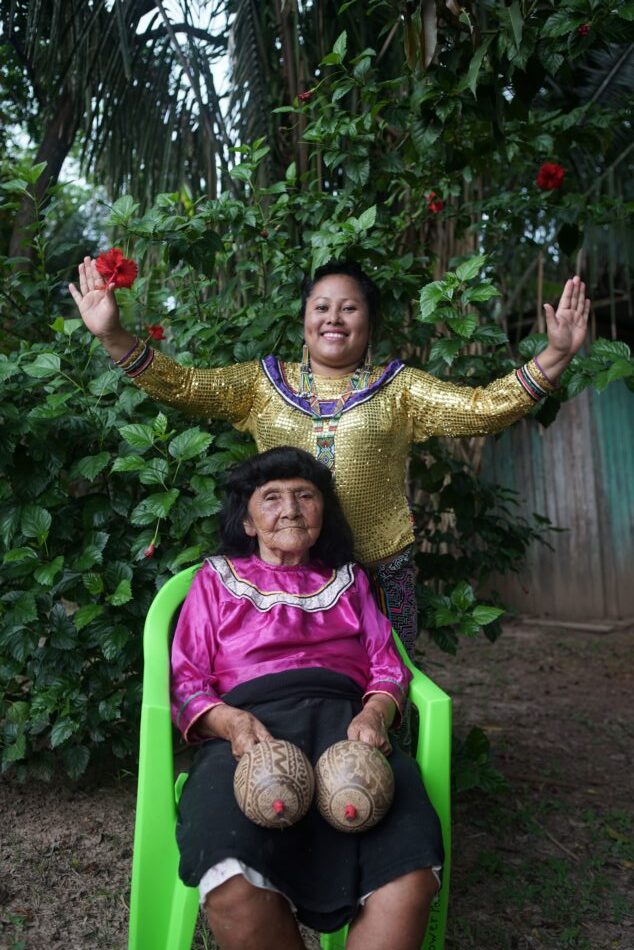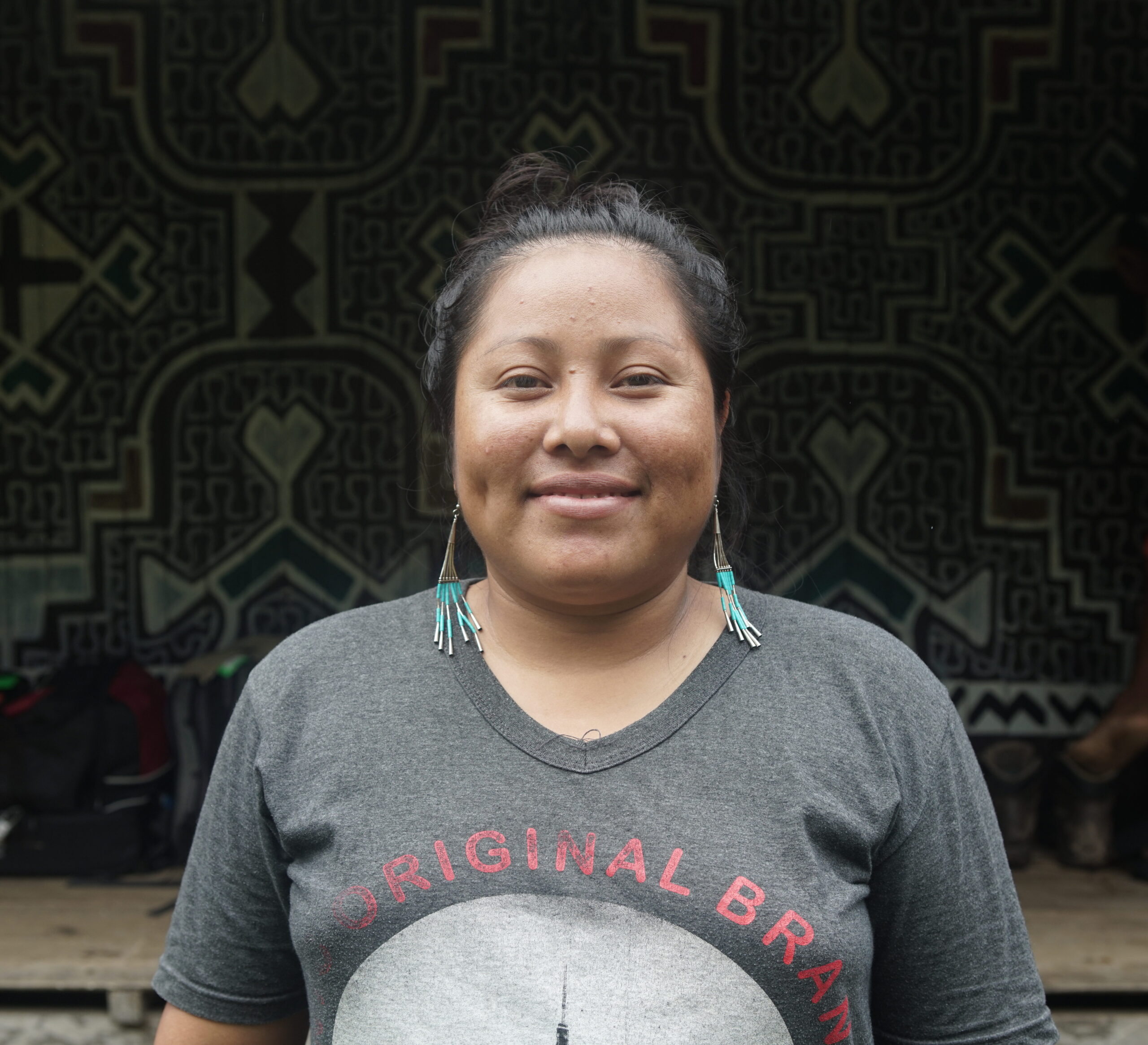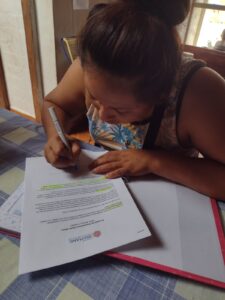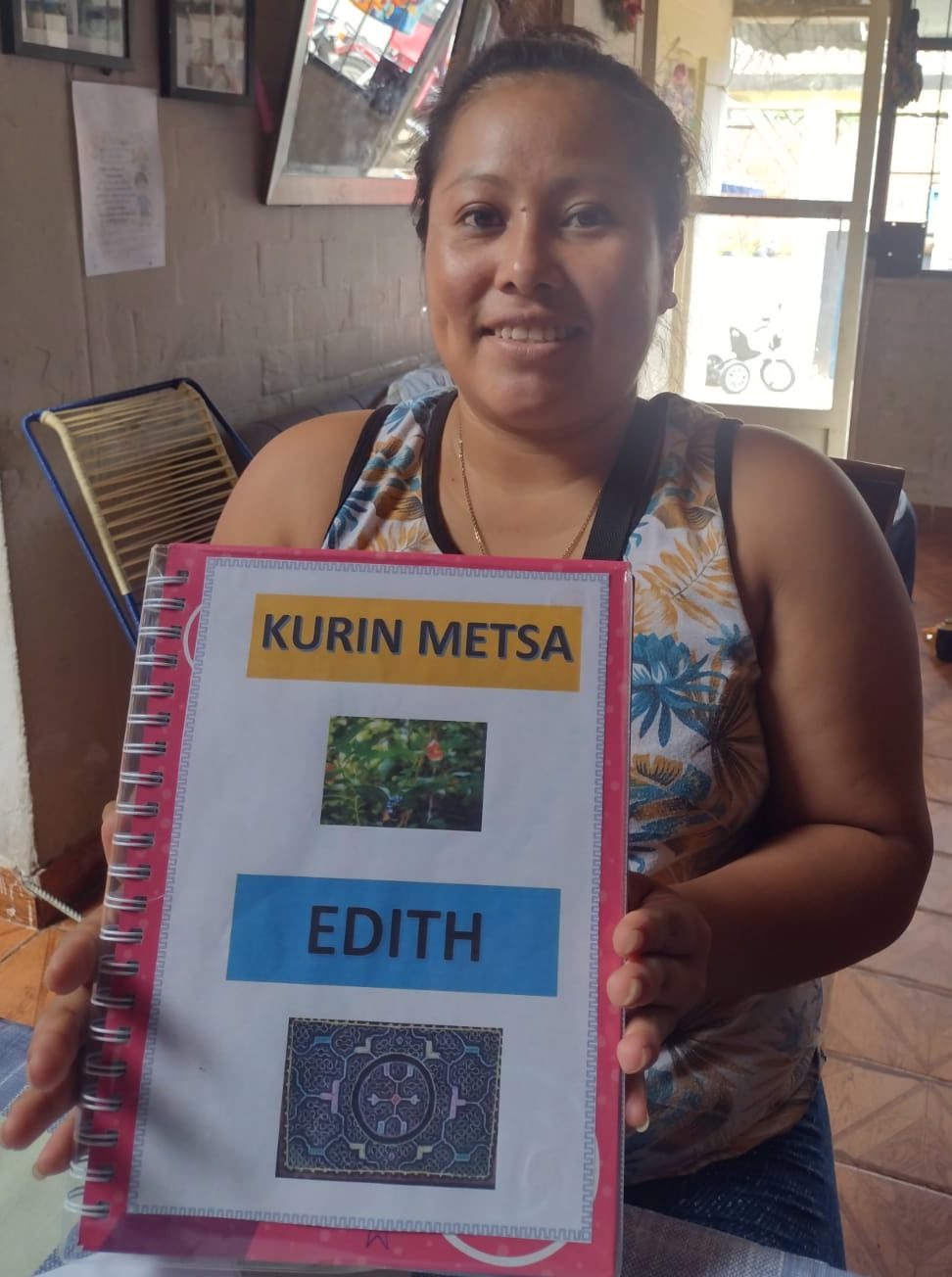by Mary Olivar, Center for Shamanic Education and Exchange Board Member

Edith Maribel Murayari Flores With Her Great Grandmother Manuela
This is the third part in a series of articles featuring the students of the Kurin Metsa School of Shamanism in Peru near the Ucayali River.
The following is drawn from a conversation between our board member, Adam Shaening-Pokrasso, and Edith Maribel Murayari Flores, a native Shipibo woman. Edith is 30 years old and began learning Shipibo healing traditions from her grandmother, Herlinda. As a child, she would accompany Herlinda on her work, which included traditional Shipibo massages and singing healing songs, or icaros, for her patients. This instilled in Edith an early affinity for healing, and a love of both song and massage as important parts of the healing modalities she now shares.

Edith
Edith has been a Kurin Metsa School student apprentice with her grandfather, Enrique Flores, for three years.
Of the students, Edith has had the most experience, and is considered a senior apprentice, and shares her experience and learnings with the other students.** The Kurin Metsa apprentice program is funded through your donations to the Center for Shamanic Education and Exchange.
“Now that Enrique is here and with the group, we are making more progress. Because before we were not interested in medicine at all. But now we see the world and it is changing, because there are many diseases, there are people who are making medicine known, and many people are working with plants. We did not have this project before and now, thankfully, this group exists. We are very happy to belong to this group, because before we did not have this opportunity.”
The Ucayali River basin where Edith and her family live, is the main headstream for the Amazon River. This area is rich in plant life and biodiversity. As an elder Onanya* who carries the wisdom of his parents, grandparents, and ancestors, grandfather Enrique is masterful in his plant knowledge and experience. He imparts this understanding of plants, their medicines, and their properties to his students through experiential learning. This includes learning how to identify the physical plants, as well as how to prepare various types of plant remedies, such as in plant baths, steams, topical applications, and teas. *Onanya is the Shipibo term for a shaman
In the Shipibo view, each type of plant contains the spirit of that plant, and in working with that plant for healing, it is important to connect with that plant spirit, to learn from it, and have a strong relationship with that plant spirit, one that is founded on gratitude and respect.
One way that the Shipibo foster this relationship is to undergo samas, or dietas. This involves a period of many days of fasting while drinking a tea of a particular plant. This is a time of concentration, contemplation, and reflection, to allow the participant to connect deeply with the plant, to communicate with it, and to build a close relationship. Through these diets, Edith has also learned healing icaro songs from each plant she diets with, which she uses to sing the medicine of that particular plant into a person to bring them that healing quality.
Some of the insights from these plants arrive as artistic inspiration. During her samas, Edith has been inspired by her experiences to honor the plants by creating paintings that include the animal guides she has connected with in scenes that also incorporate colorful patterns and energies from her visions. For example, during her camalonga plant dieta, she connected with the anaconda and with Yacumama, the powerful mother of the river, who can take the form of a great snake.
Even after the dieta is over, the connection and relationship that has been established with each particular plant continues to develop. Edith will continue to commune with each plant regularly, to receive further teachings and to keep learning from them. She finds that the best time to connect to them is early in the morning, when the plants are opening up to the new day, and rejoicing in the cooler temperatures.
“I have learned to transform myself more and be a person dedicated to plants. The plants themselves are counting on me to continue with them. So I have to be guided by the plants, to try to see what they want to teach me, to continue to be connected with them.”
One of the ways Edith has learned to work with numerous plants is in her massages and steams. She has found them especially helpful in working with people who are experiencing injuries and bone fractures.
Edith sees continuing to learn the traditions of her family as her life path.
“Tradition is what I like the most. To take those teachings and apply them. Finding more knowledge and learning about medicine has been very important. Because in the past I hardly did, but now I see that it is very, very, very important to me. I save this for the future, to teach my brothers and to teach the other people who want to learn.”
She is eager to continue her studies and to share the knowledge she has gained with others. She is proud to be a woman doing this work and through her healing path, seeks to honor her grandmother Herlinda, her original teacher and inspiration who was a master healer.
“To be a woman healer I have to pay attention, and to carry medicine for other people…to take care of people that are sick…people who do not have the possibility of going to a hospital. We can help these people. By that, I want to continue following these medicines.”
Edith deeply appreciates the chance to learn the traditions of her grandmother and grandfather and to be a keeper of the wisdoms of her family. She sees her studies as ways to enrich her own path, to honor her family, and to serve her community.
“I am very happy to continue with the medicine, Thank you!”
Edith also finds inspiration and wisdom in the Shipibo legends. Here is a retelling of one of her favorites:
There was a king of the mountains. He is called the Chullachaqui. He was that one there. There he still exists, but he is not here. But we can hear him even miles from there…in rivers where there are many very large trees, the Chullachaqui. The Chullachaquis are characters that seem human at first, like someone you know…sometimes like your father, sometimes like your brother. But his foot looks like a hoof, like a runamula. The runamula is half woman, half horse or half man, half horse.
Once upon a time there was two people who went to diet with a plant medicine. Because they would diet for a month, they went to the mountain alone for that time. The man left with his partner, his wife, because they both wanted to be powerful. But they did not want to cure and help other people. They were ambitious people who wanted to do harm to other people, and they sought to be muraya, very powerful shaman. During their diet, the man went further into the mountain, the woman followed, looking for her husband, but she couldn’t find him. Then the Chullachaqui appeared, who had blocked their path.
The Chumachaqui is powerful, he is the owner of all the trees. The woman didn’t know how to get out because the way she had come was now blocked. As night fell, the plants began to become stronger, and told her that her husband was already at her house, and to return there. This was the work of the Chullachaqui, who takes care of nature, who are the owners of the trees.
The Chaikuni (are) the king of the plants and of those medicines. You know when they are around because of the aromatic smell in the air. Both the Chullachaqui and the Chaikuni are masters of nature.
Listen to Edith sing an icaro, a sacred song that embodies healing vibrations. This particular icaro evokes the condor as well as plant medicines.
For more information on the Kurin Metsa School of Shamanism, please click the button below.

